THE BIOGRAPHY OF THE UNIVERSE - The Evolution of Life (Part 5)
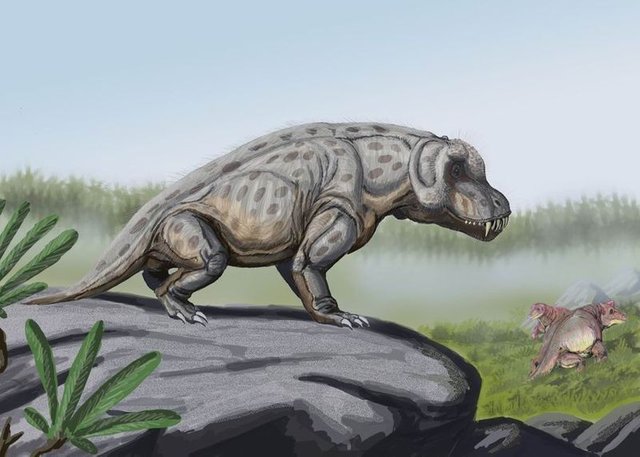
Anteosaurus in landscape by Богданов under the Creative Commons Attribution-Share Alike 3.0 Unported license.
Some weeks back, I started a series themed The Biography of the Universe where we looked at the various developmental stages our known universe has undergone, that has brought about intelligent life. This is the fifth instalment of the series, and today we will take the trail that seeks to explain the set of procedures that led to the evolutionary history of life on earth and fossils alike.
We now know that the earth has been around for roughly 4.5 billion years, and recent evidence suggests that life could have been around for as long as about 4.1 billion years. With careful analysis, biologists uncover more evidence that the similar properties in all the late evolved organisms on the earth lead to the simple implication that we all evolved together. Affecting each other in ways that kept changing us for billions of years, this means that we all have a common ancestor.
Scientists have been able to document about 5 billion different species that have lived on the earth, clearly, it is possible that we may not have documented some extinct life-forms that may have existed. Clearly, there were times in history where we were not intelligent enough to take notes of the all life-forms around us. Plus, year after year new life-forms are uncovered. Sadly or not, 99% of every life-form accounted for has gone extinct and we are the generation left.
An evaluation of all present living life forms on the earth is between 10 to 14 billion life-forms. Out of this, only about 1.9 billion life-forms or species have been named and only 1.6 billion life-forms are registered in the Central Database to date. In 2016, scientists claimed that the evaluated numbers of life-forms that have existed are 1 trillion and we have only been able to understand the nature of about one-thousandth of them.
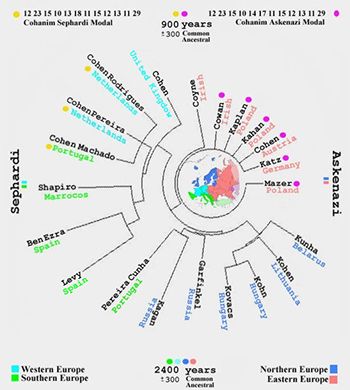
Cohanim haplotype tree by Chriscohen under the Creative Commons Attribution-Share Alike 3.0 Unported license.
The oldest indication of life on earth dates back to as long as 4.1 billion years ago. This discovery is a result of scientists finding the corpse of biological organisms that lived in rocks as old as 4.1 billion years. Coarse biotic lives where found in sedimentary rocks which were found in Western Australia.
Bacteria and archaea are the first life-forms believed to have dominated the Archean era. The major stride in our evolutionary process is also believed to have happened during this time, between themselves and their surroundings. Scientists report that the reason for this major stride is due to the evolution of photosynthesis. Which is a mechanical process that happens in plants and other organisms that generate carbohydrates and oxygen by trapping and using carbon dioxide, water and light.
This simple process was the single life source of an organism, collecting energy from its environment, using it and delivering oxygen as a waste product. With time this oxygen also became one of the major elements in the atmosphere. This process is said to have started 3.5 billion years ago and we believe that it is what led to the phenomenon called, "THE GREAT OXIDATION EVENT".
GREAT OXIDATION EVENT (GOE)
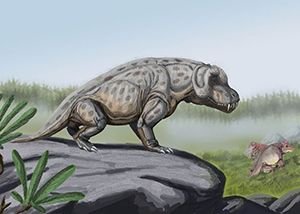
Anteosaurus in landscape by Богданов under the Creative Commons Attribution-Share Alike 3.0 Unported license.
Evidence of the sudden atmospheric change of the earth suggests that it must have happened 2.45 billion years ago. We are not yet sure about the detailed mechanisms on the earth that must have led to the event, as there may have been other sources for the mass production of oxygen that made it exponentially abundant the planet. But we are certain that photosynthesis is one of those mechanisms. About 200 million years ago, prior to the rise of the GOE, single-celled microscopic bacteria which evolved from cyanobacteria populated the earth, living on land and in water, are the first known to produce oxygen as a waste product through the process of photosynthesis.
As oxygen kept increasing in the atmosphere, it disrupted the first stable atmosphere. The free oxygen that was released, being poisonous for obligate anaerobic organisms, led to the rise of the GOE which led to the destruction of a lot of organisms. Cyanobacteria were responsible for the most significant mass extinction in the earth's history
Cyanobacteria
They are also known as Cyanophyta as any of the many photosynthetic prokaryotic micro-organisms from phylum-Cyanobacteria also known as blue-green algae. Evidence leading to the fact that cellular organisms with more complicated organelles like eukaryotes were around at about 1.8 billion years ago have been uncovered. While scientists still keep the fact open that these cellular organisms may have existed before this period, they are certain that the speed of their metabolism and evolution increased exponentially as they began to use oxygen. This event will later inevitably lead to the evolution of multicellular organisms - organisms with lots of separate cells organization doing different jobs and working together to form systems.
The evolution of reproduction played a major role to improve these organisms, which at this time, did not need sexual activities to reproduce, they reproduced asexually. Researchers are completely uncertain about the complete mysteries of the evolution of sexual reproduction, at this time of the earth's evolutionary history, it was probably not necessary. However, theorises have been postulated that this behaviour for reproduction started from a single-celled organism, a common ancestor, a single eukaryotic species.
Creatures will later evolve into having a tail, head, front and rare and other functions. These creatures evolved to dominate the 3 dimensions of space on earth and we call them - Animals. The first Bilateria is dated to have evolved half a million years ago. Evolution progressed creating systems that work to create other bigger systems that in turn also work to create other systems. Simple celled plants like algae first appeared on the earth about a billion years ago. Complex plant systems appeared much later, about 850 million years ago.
Devonian Extinctions
These micro-organisms are said to be responsible for every accountable life on earth. The evolution of complex plants that stayed on land prospered so much that they are suspected to have played a major role in causing series of marine life extinctions. This is a set of extinctions that occurred millions of years ago, 419.2 - 359 to be precise. For now, no one has been able to produce solid evidence that accounts for the exact causes of the Devonian extinction. However, researchers have provided a variety of causal links related to the event such as:
Excessive sedimentation, rapid global warming or cooling, bolide (meteorite or comet) impacts, or massive nutrient runoff from the continents. Collectively, the extinctions (which include the Lower Zlichov, Taghkanic, Kellwasser, and Hangenberg events).
This event is said to be one of the five outstanding extinctions that ever happened in evolutionary history, it is ranked lowest in the list, yet, about 80 percent of animal life were destroyed at this time.
Ediacaran biota
These are sea creatures that existed during the Ediacaran era. Their fossils give us the knowledge that they existed about 635 to 541 million years ago. They are fascinating because they had skeletons, long before other animals had skeletons.
Cambrian Explosion
This term refers to the sudden outburst of animal life. It is notable on the geological timescale because of lots of found fossils and skeletal relics that were dated all lead back to a certain range of time, about 542 million years ago.
As the exponential increase in diversity of animals allowed the formation of interrelationships between species. Such relationships lead to the strife for survival, making some animals predators and others prey. As animals formed larger groups, their interactions became increasingly complex, much more complex than their ancestors. With time they occupied the aquatic realm and transformed it into their natural dwelling.
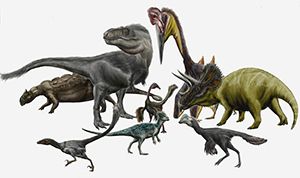
Hell Creek Dinosaurs and Pterosaurs by Durbed under the Creative Commons Attribution-Share Alike 3.0 Unported license.
Mammals that dominated the lands during this time were later almost completely wiped out by the occurrence of a mass extinction known as the Permian - Triassic extinction which happened about 252 million years ago. After this, ruling-reptiles (Archosaurs) dominated the land. They consisted of lizard-like and bird-like animals that come in outrageously different sizes. " one archosaur group, the dinosaurs, dominated the Jurassic and Cretaceous periods"
Another extinction event occurred called the Cretaceous—Paleogene extinction and this time it killed off the large and flightless dinosaurs; allowing for the evolution of mammals. Such extinctions allow for the diversification of other sets of organisms.
References
BURGESS SHALE | Cambrian Explosion
SCIENCE DAILY | Ediacara Biota flourished in bacterially rich marine habitats
BBC | Big Five mass extinction events
THE BIOGRAPHY OF THE UNIVERSE SERIES
Part 1 - Birth of the Universe
Part 2 - The Formation of Solar Bodies

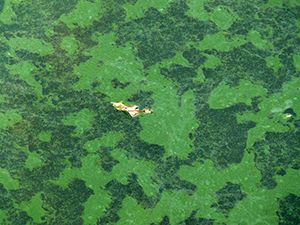

Your post has been selected as #adsactlyspostoftheday :)
Join us in our Discord channel here to drop your post in our post promotion page, and make sure to use the @adsactly tag in the post itself.
Many thanks @adsactly!
Congratulations
excellent publication, greetings and I follow you good content .. I invite you to observe my content
Thanks
From my paspective,i dont believe in these.because of the in diversity of speech can originate in a source.And what methods was used by scientist in making this resrarch.Great post.it takes me back to my biology class
Well... To give a full account of all the process that scientists considered before concluding those facts would take another article. But you can start with knowing that they are backed up with fossil evidence, carbon dating and anthropological investigation. The article announces the origin of man via natural selection in the theory of evolution.
connecting this:
and this:
It's interesting how that life started with anaerobic microorganisms and then evolved to these Cyanobacteria which by photosynthesis (a creative process, nonetheless) brought about the demise of a lot of the earlier ones. What's next for earth in the next billion years? Chlorine-breathing trees and Elephants?
Good read man.
By that point, I am certain all life forms on the Earth will be extinct. The most probable fate of this planet is absorption by the Sun in about 6 - 7 billion years after the Sun has entered the red giant phase and expanded beyond the planet's current orbit. After consuming Mercury and Venus, and its last stop with be our little bluish-green planet. Mars will survive though, but the planet will spin out of orbit, due to the absence of the Sun's gravity.
What a time to be alive then.
Absolutely!
You received a 60.0% upvote since you are a member of geopolis and wrote in the category of "geology".
To read more about us and what we do, click here.
https://steemit.com/geopolis/@geopolis/geopolis-the-community-for-global-sciences-update-4
Many thanks! @geopolis
Keep up the great work @agbona! I enjoyed your post so much!
Looking forward to your next blog.
ps I had never heard of the GOE. Thanks for the education!
I am truly honoured that you find the post interesting, and more importantly, that you learn something new.
Although this post is the fifth part of a series that I tag "The Biography of the Universe" there is the final sequel to this post where I wrote about Man's evolution, you can find it here
Always a pleasure having you comment on my post.